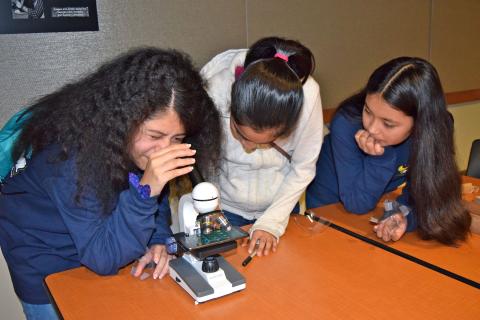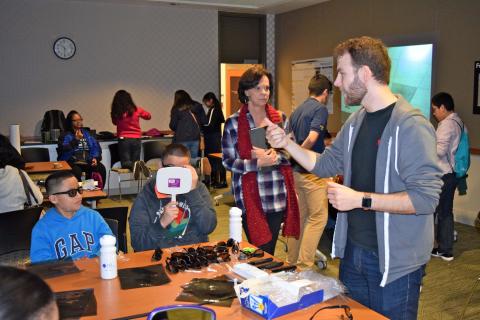A team of volunteers put together by Sean Rodrigues, a Ph.D. student in the School of Electrical and Computer Engineering (ECE) at Georgia Tech, held a mini workshop series titled "A Day of Light" that aimed to both unify the concept of optics to K-12 students and to introduce them to career pathways in the field.
Lights, Camera, and Action! Except this time it wasn't filming that was taking place March 18 on the Georgia Tech campus. A team of volunteers put together by Sean Rodrigues, a Ph.D. student in the School of Electrical and Computer Engineering (ECE) at Georgia Tech, held a mini workshop series titled "A Day of Light." The workshop, funded by an SPIE outreach cycle grant, aimed to both unify the concept of optics to K-12 students and to introduce them to career pathways in the field.
From lasers to sunglasses, students were immersed into a series of exercises that prompted them to question how conventional optical devices operated. Microscopes zoomed into cell phones to show how three colors in a single pixel can fill our screens with the breadth of color that we see around us. IR signals from remote controls were visualized by cellphone cameras, holographic displays were created using phones as backlights, and underlying principles of polarization described how 3D glasses give us the third dimension we experience in theaters.
The workshop hosted over 200 K-12 students from the broader Atlanta area, reaching as far out as Roswell and Norcross. The "Day of Light" was one of a series of science outreach events held in Atlanta including the 5th Annual Latino College and STEM Fair and the Atlanta Day of Science. CEISMC–the Center for Education Integrating Science, Mathematics, and Computing–organized the STEM fair, providing funding for school systems to attend from outside the metro Atlanta area and allowing for the workshop to have influenced a greater sphere of students, especially those from Hispanic and Latin American backgrounds.
Rodrigues, who submitted a proposal for the workshop and was awarded the grant by the Society of Optics and Photonics (SPIE), explained that "optics is a career field that is often overlooked by up and coming scientists, but is extremely prevalent in our day-to-day lives." He goes on to describe how a larger group of people who specialize in the field earlier on in their careers could promote faster advances in optical technologies from telecommunications in fiber optics to future display systems. Only a handful of schools in the United States offer optics degrees, one being Rodrigues’ alma mater, the University of Rochester. Having joined the field himself later in life, he finds himself committed to educating students about the field earlier on in their careers.
Rodrigues was awarded the “Outstanding Service to Georgia’s Community Award” by the School of ECE in 2016 and continues to support the community by promoting the sciences to students of all ages. He would like to thank his team, U.S. Army 1st Lt. Tejas Pathak; Stefany Holguin and Alex Bryant, Ph.D. students in the School of Material Science and Engineering (MSE); and ECE Ph.D. student Mohammad Taghinejad for their hard work in pulling the event together.
Article written by Sean Rodrigues
Additional Images


